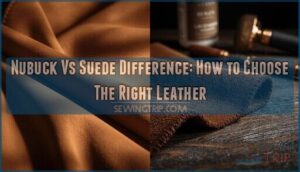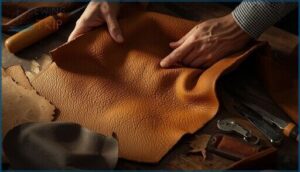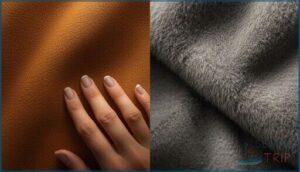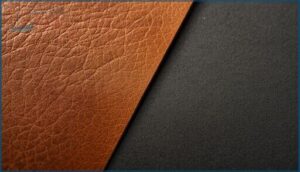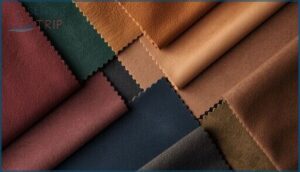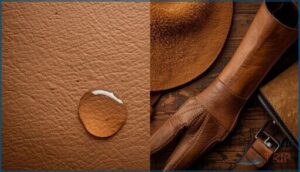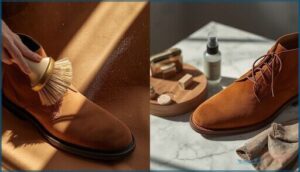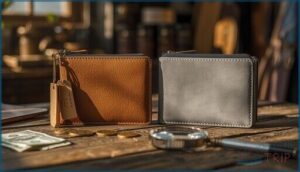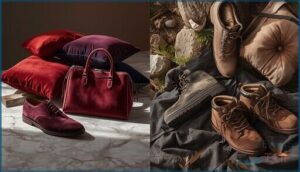This site is supported by our readers. We may earn a commission, at no cost to you, if you purchase through links.
You run your hand across what the salesperson calls “suede,” but something feels off—the texture is denser, almost like fine sandpaper rather than the plush softness you expected. You’re not imagining things. The leather world has been pulling a fast one on shoppers for decades, conflating two distinctly different materials under the same fuzzy umbrella.
Nubuck and suede might look like cousins at first glance, but they come from opposite sides of the hide and behave like entirely different animals. One laughs at scuffs while the other shows every coffee spill; one costs nearly double while the other keeps your wallet happy.
Understanding the nubuck suede difference isn’t just leather geek territory—it’s the key to avoiding buyer’s remorse on that $300 jacket or those boots you’ll wear three hundred times.
Table Of Contents
- Key Takeaways
- What is Suede Leather?
- What is Nubuck Leather?
- How Are Suede and Nubuck Made?
- Texture and Appearance Differences
- Durability and Longevity Comparison
- Care and Maintenance Tips
- Cost and Accessibility
- Best Uses for Suede Vs Nubuck
- How to Tell Suede and Nubuck Apart
- Choosing The Right Material for You
- Frequently Asked Questions (FAQs)
- Conclusion
Key Takeaways
- Nubuck comes from the outer grain side of the hide and delivers 2-3 times better durability than suede (which uses the inner split layer), making it the smarter choice for daily wear items like boots and bags that face real abuse.
- Suede feels softer and fluffier but shows every stain and water spot immediately, while nubuck’s denser texture resists scuffs and moisture better—though neither material is naturally waterproof without protective treatments.
- You can spot the difference by checking for natural grain markings (pores and wrinkles visible only in nubuck) and running your fingers across the surface—nubuck feels firmer and more velvety, while suede compresses easily with a shaggier pile.
- Nubuck costs 20-40% more than suede upfront, but the math flips when you factor in replacement costs—nubuck lasts years longer with basic monthly brushing, while suede demands protective sprays after nearly every use and still wears out faster.
What is Suede Leather?
Suede leather brings that soft, luxurious feel you’ve probably noticed on jackets, shoes, and high-end accessories. It’s made differently than other leathers, which gives it a distinct look and texture that sets it apart.
Let’s break down where it comes from, what makes it unique, and where you’ll actually see it used.
Material Origins and Characteristics
Suede comes from the underside of animal hides—think lambs, goats, calves, or deer. This is the corium layer, where fibers run looser and create that signature soft, fuzzy feel. Younger animals yield finer suede because their hide layers haven’t toughened yet.
The tanning methods used—chrome or vegetable—preserve the leather while keeping its lightweight, flexible fiber structure intact. Material density stays lower than nubuck, making suede ideal for fashion-forward pieces.
Suede leather is known for its luxurious feel properties that make it a popular choice for various applications.
Texture and Appearance
You’ll notice that velvety texture the moment you run your fingers across it—softer and shaggier than nubuck’s tighter nap. The surface texture creates a deeper, fluffier pile with a pronounced matte look. Unlike leather grain found in full-grain materials, suede’s uniform appearance lacks natural pores or wrinkles.
Color depth tends toward lighter, pastel shades, giving it relaxed material aesthetics perfect for casual style. Understanding the leather finish types is essential for making an informed decision.
Common Applications of Suede
That soft texture naturally steers designers toward items where comfort trumps heavy-duty use. You’ll find suede everywhere in fashion-forward circles:
- Footwear – Loafers, boots, and sneakers hit 20 million units yearly, especially in autumn collections where warmth matters.
- Fashion apparel – Jackets, blazers, and pants dominate luxury goods at 25 million pieces annually.
- Accessories – Handbags alone account for 15 million units, plus belts and wallets riding steady 9% growth.
- Upholstery – Chairs and sofas reach 10 million units, claiming 32% of premium furniture sales.
- Automotive interiors – High-end vehicle seats use 30 million fabric units for that plush finish.
Fashion trends favor suede when style outweighs ruggedness, making it the go-to leather for statement pieces and seasonal shoe designs.
What is Nubuck Leather?
Nubuck leather flips the script—it’s crafted from the outer hide instead of the inner layer, giving it a tougher build with that same velvety touch. Picture full-grain leather—the strongest part of the animal’s skin—lightly sanded to create that signature soft surface. This is where material science meets leather crafting at its finest.
Unlike suede, nubuck keeps its natural grain markings—those tiny pores and wrinkles that prove you’re holding genuine leather. It’s usually made from high-quality hides like calfskin or cowhide, which explains why it stands up to daily wear better than most leather types.
You’ll spot nubuck on everything from rugged hiking boots to sleek handbags. Its durability makes it perfect when you need something that looks refined but won’t fall apart after a few months. Think of it as leather with backbone—stylish enough for city streets, tough enough for real life. Proper nubuck care keeps it looking sharp for years.
How Are Suede and Nubuck Made?
You might think suede and nubuck look similar, but they start from completely different parts of the hide.
The production process for each one shapes everything from texture to durability. Here’s how manufacturers turn raw leather into these two distinct materials.
Suede Production Process
Think of suede as a transformation of the hide’s inner surface—split, sanded, then brought to life.
- Raw Material Sourcing: Over 80% comes from sheep, cow, and pig hides chosen for softness
- Hide Curing Methods: Salt preservation uses up to 25 kg per ton before processing
- Tanning Chemicals: About 60% relies on chromium salts for durability
- Dye Penetration: Water-based dyes reach 90% of the fibril structure for uniform color
Nubuck Production Process
You’ll find nubuck leather production starts with selecting premium outer hides—70% from steer sources chosen for their denser, more durable grain.
Tanning methods like chromium processing handle 80% of commercial output, cutting production time dramatically.
Sanding techniques use ultra-fine 220–400 grit pads on the grain side, creating that velvety surface you recognize.
Leather finishing often includes hydrophobic coatings, boosting water resistance by 50% while preserving breathability and natural markings.
Key Differences in Manufacturing
Raw Material Sourcing sets them apart from the start—suede uses split hides, accounting for 60% of total yield, while nubuck demands top-grain cuts, representing less than 40%.
Tanning Processes favor chromium methods for both, but nubuck requires 17% longer processing times.
Surface Finishing differs too: suede gets coarser sanding for that fuzzy pile, while nubuck receives precision buffing with fine-grit abrasives, creating its velvety touch.
Texture and Appearance Differences
You can tell suede and nubuck apart the moment you touch them, but there’s more to their differences than just feel.
Each material has distinct visual traits that affect how it looks on your shoes, jacket, or bag. Let’s break down what sets them apart in texture, grain, and finish.
Surface Feel and Look
When you run your fingers across these leathers, you’ll immediately notice distinct surface personalities. Nubuck’s nap height sits at 0.3–0.5 mm, delivering a controlled, velvety texture that feels dense and uniform. Suede reveals a longer, more visible nap with open, looser fibers—softer and fluffier to touch. Here’s what defines each tactile experience:
- Nubuck offers a firm, structured surface with subtle visual aesthetics and natural leather grain.
- Suede provides outstanding plushness through its thinner, more flexible composition.
- Nubuck’s surface texture maintains consistency across products due to its top-grain origin.
- Suede’s tactile experience feels lighter and more malleable under pressure.
- Both materials deliver breathability while creating distinctly different sensory impressions.
Grain and Markings
Nubuck’s grain side reveals the hide’s authentic story—natural pores, subtle scars, and fine wrinkles create character you can see and feel. Suede lacks these grain patterns entirely since it’s made from the flesh side, giving you a uniform, mark-free surface.
That fiber texture difference matters: nubuck shows the leather’s genuine history while suede offers consistent smoothness. Quality enthusiasts prize nubuck’s visible imperfections as proof of authenticity.
Color and Finish Options
Both materials now break free from traditional neutral limits—suede offers over 40 color choices, while nubuck provides 30-plus options to match your style.
The finish types you’ll encounter include:
- Matte napped surfaces for suede’s signature soft look
- Velvet-like finishes on nubuck with subtle sheen from grain sanding
- Oil-based pull-up treatments that lighten when flexed, boosting water resistance
Pigment choices and dyeing methods let you customize either leather texture beyond basic browns.
Durability and Longevity Comparison
When you’re investing in leather, you want it to last. Nubuck and suede handle daily wear very differently, and understanding these differences can save you from buyer’s remorse down the road.
Let’s break down how each material holds up against scratches, spills, and the rigors of everyday life.
Resistance to Wear and Tear
When choosing between nubuck and suede, understanding material fatigue and tear resistance is essential. Nubuck delivers enhanced durability factors—withstanding tensile strength of 15–25 MPa versus suede’s 10–15 MPa. Abrasion testing shows nubuck outlasts suede by 2–3 times under identical wear patterns, making it ideal for demanding use where leather durability matters most.
Nubuck outlasts suede by 2–3 times in abrasion testing, withstanding 15–25 MPa tensile strength versus suede’s 10–15 MPa
| Factor | Nubuck | Suede |
|---|---|---|
| Tensile Strength | 15–25 MPa | 10–15 MPa |
| Lifespan (Daily Use) | 2–3 years+ | 1–2 years |
| Abrasion Cycles | High resistance | Visible wear at 20,000 cycles |
| Best For | Heavy-duty footwear, bags | Fashion accessories, light use |
Water and Stain Resistance
Beyond wear tolerance, water resistance, and stain resistance reveal where nubuck truly pulls ahead. Neither material is naturally waterproof, but nubuck’s denser grain structure offers moderate moisture protection. Suede’s open pores absorb liquids fast—causing permanent stains and shape loss without waterproof coatings. Moisture damage hits suede hardest, while treated nubuck withstands light rain better, making leather treatments and resistance testing critical for longevity.
| Factor | Nubuck | Suede |
|---|---|---|
| Natural Water Resistance | Moderate (denser fibers) | Low (highly absorbent) |
| Stain Susceptibility | Lower with treatment | High without protection |
| Effect of Water Exposure | Returns to normal after drying | Stiffens, watermarks remain |
| Stain Removal Difficulty | Moderate | Difficult to impossible |
Suitability for Everyday Use
Real-world daily wear factors matter more than theory. Nubuck manages regular friction better—your boots or bags maintain shape and resist scuffing for years with basic care routine habits. Suede demands gentler treatment and shows flattening or fading faster under constant use. For practical comfort combined with leather durability, nubuck wins everyday scenarios. Suede shines in occasional wear where style trumps rugged demands.
| Material Selection | Nubuck | Suede |
|---|---|---|
| Daily durability | Excellent—resists scuffs, lasts years | Fair—shows wear within months |
| Usage Patterns | Intensive daily use, workwear | Occasional, style-focused wear |
| Maintenance frequency | Every 6 months (routine) | Monthly or after each use |
| Comfort vs. resilience | Balanced support and softness | Premium softness, less structure |
| Water Resistance impact | Moderate protection with treatment | High vulnerability, needs frequent proofing |
Care and Maintenance Tips
Both suede and nubuck need consistent care to keep their texture and appearance intact. Without the right routine, these materials lose their character fast.
Here’s how to maintain each type and protect your investment properly.
Cleaning Suede Leather
You’ll need the right tools to keep suede leather looking sharp. A suede brush lifts dirt and restores texture in about 70% of cases, while suede erasers tackle 77% of dry stains. For oil-based marks, foam cleaning products work on roughly 65% of stains.
Apply water repellents after cleaning, and always use leather conditioners sparingly to maintain that signature soft finish.
Cleaning Nubuck Leather
Nubuck demands a lighter touch than you might expect. Start with a soft-bristled brush on completely dry leather, working in the direction of the nap.
For stubborn stains, try a nubuck eraser with gentle circular motions—effective on roughly 80% of marks. Use foam-based cleaners sparingly, never over-wetting the surface.
After cleaning, restore water resistance with a quality leather protector designed specifically for nubuck care products.
Protective Treatments and Storage
After waterproofing treatments, proper storage solutions complete your leather protection strategy. Keep suede and nubuck in breathable cotton bags—they cut mildew risk by 60% compared to plastic.
Maintain humidity control between 35–70% to prevent cracking or mold. Apply protective coatings annually for ongoing water resistance.
Stuff items with acid-free tissue for shape retention, and brush every few months to preserve that signature texture through leather conditioning.
Cost and Accessibility
Price matters when you’re choosing between nubuck and suede, but it’s not the only thing to factor in. You’ll also want to know where to find quality pieces and what signs tell you you’re getting the real deal.
Here’s what you need to know about cost, availability, and how to spot worthwhile leather.
Price Comparison
Your wallet feels the difference before your fingers do. Nubuck leather usually costs 20–40% more than suede—mid-range suede jackets run $150–$300, while luxury nubuck footwear starts around $400–$700.
This price gap reflects durability and material quality. Retail pricing mirrors market trends: suede sits as budget-friendly, nubuck stakes its claim in luxury brands.
Cost analysis reveals you’re paying for longevity, not just leather.
Availability in Market
Finding what you want depends on where you shop. Suede floods the market—from fast fashion to luxury brands—while nubuck hides in premium collections. Here’s where global distribution shapes your choices:
- Online platforms dominate, capturing 35–45% of retail channels for both leather types
- Asia-Pacific leads consumer demand, especially China and India’s booming markets
- Specialty stores stock nubuck’s premium offerings versus suede’s mass-market presence
- Europe and North America maintain established regional sourcing for fashion items
Market trends favor accessibility for suede, exclusivity for nubuck.
Quality Considerations
Price tags don’t always reflect true leather grade or material strength. You’ll find top-shelf nubuck with natural grain markings passing rigorous durability tests, while budget suede crumbles under stress.
Texture variance matters—premium finishes resist wear better. Check thickness, tanning methods, and finish options before buying.
Real durability and leather care demands outweigh initial cost when quality leather outlasts cheaper alternatives by years.
Best Uses for Suede Vs Nubuck
Choosing between suede and nubuck comes down to how you’ll actually use the item. Suede works best when you want elegance and comfort for lighter-duty applications, while nubuck manages everyday wear and outdoor conditions without breaking a sweat.
Here’s how each material performs across footwear, accessories, and furniture.
Footwear Selection
Choosing between nubuck and suede for shoes comes down to how you’ll wear them. Nubuck manages daily use better, lasting two to three times longer than suede in similar conditions. If you’re moving through unpredictable weather or need sturdy footwear, nubuck’s excellent wear resistance and modest water tolerance win. Suede shines in dress shoes and warm climates where its breathability and plush texture matter more than durability.
| Feature | Nubuck Shoes | Suede Shoes |
|---|---|---|
| Durability | Lasts 2-3x longer | More prone to wear |
| Maintenance Needs | Spray every 2-3 months | Spray every 4-6 weeks |
| Best For | Daily wear, outdoor use | Fashion shoes, dry climates |
| Cost Factors | Higher price point | More budget-friendly |
Your maintenance commitment matters too. Nubuck requires weekly brushing and stain protection every few months, while suede demands attention every month or so, especially in moisture. Style preference plays a role—nubuck’s natural grain offers a refined, rugged look, whereas suede’s soft texture feels luxurious against the skin. Both materials need specialized brushes and protective sprays, but nubuck forgives neglect better than suede. Consider where you live and how often you’ll wear the shoes before committing.
Bags, Jackets, and Accessories
Bags and jackets shift the priorities. Suede works beautifully for fashion accessories and lighter jackets where that soft, vintage texture matters—think fall ’25 trends with earth tones. Nubuck manages daily-use bags and structured accessories better, resisting scuffs and moisture that destroy suede fast. The leather crafting quality shows: nubuck costs more but survives rough treatment, while suede demands careful handling for its plush appeal.
| Aspect | Nubuck Items | Suede Items |
|---|---|---|
| Best Applications | Handbags, wallets, belts | Jackets, gloves, fashion bags |
| Market Position | Premium ($50-500+) | Accessible ($30-300) |
| Durability | High wear resistance | Delicate, needs frequent care |
| Style Preferences | Refined, structured look | Soft, vintage aesthetic |
| Care Frequency | Every 2-3 months | Monthly protection needed |
Upholstery and Furniture
Furniture changes everything. Nubuck dominates high-use upholstery with tensile strength hitting 15-25 MPa versus suede’s 10-15 MPa—that’s serious durability for sofas taking daily punishment. Suede works for accent pieces where leather texture and fabric selection prioritize aesthetics over function. Material sustainability matters less than practical furniture design choices: nubuck’s breathability and water resistance beat suede every time for upholstery trends demanding both comfort and longevity.
| Factor | Nubuck Upholstery | Suede Upholstery |
|---|---|---|
| Durability Rating | High (15-25 MPa strength) | Moderate (10-15 MPa) |
| Best Furniture Use | Daily sofas, chairs | Decorative accent pieces |
| Maintenance Need | Bi-monthly brushing | Frequent protective care |
| Leather Finishes | Natural grain, varied thickness | Uniform, soft appearance |
How to Tell Suede and Nubuck Apart
When you’re standing in a store holding a piece of leather, you need to know what you’re actually buying. Suede and nubuck look similar at first glance, but a few quick checks will reveal the truth.
Here’s how to identify each material with confidence.
Visual Inspection Techniques
You can spot the difference between suede and nubuck through careful visual inspection. Fiber analysis under good lighting reveals distinct characteristics: nubuck shows a fine, densely packed nap with subtle grain markings, while suede has a looser, more uniform texture.
Edge inspection provides another clue: suede displays rough, fibrous edges, whereas nubuck appears firmer. Additionally, color testing under UV light highlights nubuck’s uneven dye absorption compared to suede’s homogeneous finish.
Touch and Texture Tests
Beyond what you see, touch reveals the truth. Run your fingers across both surfaces: suede feels plusher and softer, with higher fiber density creating that luxurious sensation. Nubuck’s velvety texture is firmer, with lower surface roughness.
Press gently—suede compresses more under pressure and shows greater moisture absorption when damp. This tactile sensation test, combined with texture durability under repeated rubbing, helps you confidently identify each leather type.
Identifying Natural Markings
Nature leaves clues everywhere. Inspect nubuck under bright light—you’ll spot visible pores, healed scratches, and wrinkle patterns in most pieces, thanks to its grain-side origin.
Suede’s split-layer construction hides these natural patterns, giving it a consistent, blemish-free surface.
This marking identification through surface inspection confirms material authenticity and helps you distinguish genuine leather grain from uniform texture in suede versus nubuck leather comparison.
Choosing The Right Material for You
Picking between nubuck and suede isn’t about which one’s objectively better—it’s about what fits your life. You need to weigh how you’ll actually use the leather, how much time you’re willing to spend caring for it, and whether it matches your personal style.
Let’s break down the key factors that’ll help you make the right call.
Lifestyle and Usage Needs
Your lifestyle shapes your leather choice more than you think. Daily wear needs and outdoor activities demand nubuck’s durability and water resistance—over 60% of daily users prefer it for retaining shape under regular use.
Fashion preferences and occupational requirements might lean toward suede’s elegance for occasional outings.
Travel demands favor nubuck’s resilience, with 43% of frequent travelers citing better stain resistance for gear that moves.
Maintenance Preferences
Honestly, your tolerance for maintenance schedules determines your pick. Suede demands brushing after nearly every use and cleaning 34% more often—81% of owners apply protective treatments before first wear.
Nubuck? Weekly brushing suffices, and you’ll stretch waterproofing intervals to four weeks instead of three. If you’d rather minimize leather care routines while maintaining water resistance and stain removal effectiveness, nubuck wins the leather durability guide comparison.
Style and Fashion Considerations
Fashion trends reveal suede’s dominance in fall runways—30% more presence than last year, especially in vintage styles and bohemian looks. Earth tones like tan and camel drove 68% of suede jacket sales, while nubuck’s matte finish captured luxury brands’ spring collections.
Millennials favor suede’s dramatic flair; you’ll find nubuck in understated leather aesthetics. Seasonal colors and leather care accessibility ultimately shape your pick.
Frequently Asked Questions (FAQs)
Is nubuck the same as leather?
Yes, nubuck is genuine leather. It’s top-grain hide that’s been sanded to create that signature velvety texture—unlike synthetic imitations, it retains natural grain markings, pores, and the structural integrity that comes from real animal hide.
What is the difference between Suede & Nubuck leather?
Suede comes from the hide’s inner layer, with a fuzzy texture, while nubuck uses the outer grain for a velvety feel.
Nubuck resists wear better, but suede offers peerless softness and flexibility.
What is the difference between Suede & nubuck?
The material science behind these luxury goods reveals a fundamental divide: nubuck comes from the outer hide with visible grain, while suede emerges from the inner split, creating distinct leather types with contrasting durability.
Why does nubuck sanding look like Suede?
Both leathers undergo sanding to raise fine fibers on the surface, creating that signature velvety nap.
The buffing process exposes similar microfiber structures, which is why nubuck mimics suede’s soft, matte finish so closely.
What does nubuck look like?
Picture “velvet rebellion” for your feet—nubuck leather showcases a velvety texture with fine, uniform surface grain.
Its matte leather finish reveals subtle nubuck patterns and natural markings, creating rich material aesthetics that shift beautifully under light.
What kind of hide is nubuck made of?
You’ll find nubuck leather crafted from the outer grain side of top-quality animal hides—usually cowhide or calfskin.
This premium leather source gives nubuck its natural durability and distinctive grain markings that suede simply can’t match.
Is nubuck better than suede?
Better? That depends on your battlefield. Nubuck beats suede in durability tests and water resistance by 2-3 times, making it king for daily wear.
But suede wins for softness and fashion trends prioritizing elegance over endurance.
How to tell nubuck from suede?
Check for grain marks—nubuck shows natural pores and wrinkles, while suede looks uniform. Run your fingers across the surface: nubuck feels denser and smoother, suede softer and fuzzier.
What are the cons of nubuck leather?
Like a high-maintenance friend, nubuck demands constant attention. Water damage risks, color fading from sunlight, and high maintenance routines make ownership challenging.
Additionally, environmental impact from chemical treatments and durability issues without protective care further complicate its upkeep.
Is nubuck good quality?
Yes, nubuck delivers outstanding quality. This premium leather boasts tensile strength of 15–25 MPa, outlasting suede’s 10–15 MPa. With proper care, nubuck leather products can last decades, combining durability with luxurious softness.
Conclusion
What’s the point of falling for leather if you can’t tell what you’re buying? The nubuck suede difference boils down to this: nubuck gives you toughness with top-grain origins, while suede trades durability for softness from the underside.
Match the material to your life—not the other way around. Your next leather purchase doesn’t need to be a gamble. Armed with texture, care requirements, and honest pricing knowledge, you’ll choose like someone who actually knows their hides.
- https://www.bikishoecare.com/blog/suede-vs-nubuck-and-clean-care-guide/
- https://www.carlfriedrik.com/magazine/nubuck-vs-suede
- https://www.arcanefox.com/blogs/fix-blogs/what-is-nubuck-leather-how-is-it-different-from-suede-leather
- https://www.cheaney.co.uk/blog/nubuck-vs-suede/
- https://www.alpinetrek.co.uk/blog/nubuck-leather-pros-cons/

